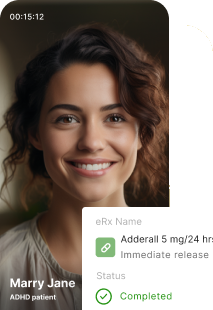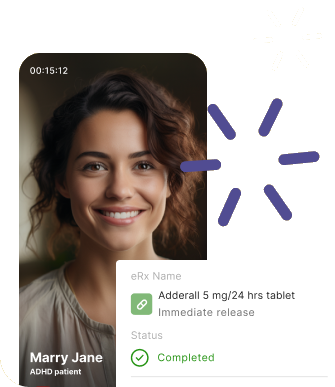Living with attention deficit hyperactivity disorder (ADHD) often means the world looks and sounds overwhelming. From crowded spaces to fast-paced conversations, neurotypical activities can become difficult when your brain struggles to filter information and keep up. This overstimulation can lead to feelings of frustration, sadness, or exhaustion.
Sensory or emotional overstimulation from ADHD is very common, but it’s frequently misunderstood or ignored. Below, we’ll explore what ADHD overstimulation looks and feels like, its common triggers, and how you can manage or reduce your symptoms.
Highlights
- People with ADHD get overstimulated when the brain becomes flooded by too much sensory or emotional input, leading to irritability, difficulty functioning, or shutdown.
- Executive dysfunction and impaired attention in ADHD make it harder to filter out irrelevant stimuli, increasing the risk of overstimulation.
- Overstimulation triggers vary but often include loud environments, emotional stress, too much multitasking, and sensory overload from everyday situations.
- Ways to deal with overstimulation involve preventive strategies, immediate coping tools, and lifestyle changes tailored to your specific needs and environment.
What Is ADHD Overstimulation?
Overstimulation, or sensory overload, occurs when the brain is overwhelmed by multiple senses simultaneously, such as sights, sounds, touches, smells, or tastes.
Research shows that people with ADHD are more likely to feel overstimulated because their brains have difficulty sorting through and deciding what to pay attention to.
For people with ADHD, specific brain structures like

Research has also found that children with ADHD have


Is Overstimulation the Same as Hypersensitivity?
No.
Meanwhile, ADHD-caused overstimulation happens when the brain takes in too much at once. It’s triggered and situational, not a constant sensitivity.
What Does ADHD Overstimulation Feel Like?
ADHD overstimulation symptoms can feel overwhelming, confusing, and even physically uncomfortable. However, the experience is different for everyone. While symptoms vary, there are several common emotional and physical signs of overstimulation many people with ADHD share.
How It Feels Physically
- Nausea. It may come on suddenly and feel like motion sickness, especially in crowded, noisy, or chaotic environments. It can interfere with eating, commuting, or focusing on tasks.
- Brief memory lapses. If you’re overstimulated, you might forget what you were saying mid-sentence or lose track of what you were doing. These memory lapses disrupt conversations, daily routines, and work productivity.
- Heart palpitations. These sensations often feel like your heart is racing or fluttering, typically in response to stress or sensory overload. It can be alarming and may lead to avoidance of stimulating environments, such as stores or loud workplaces.
- Fatigue. This is mental and physical exhaustion that may or may not improve with rest. It can make it challenging to initiate tasks, socialize, or maintain responsibilities.
- Trouble hearing. This is not a complete loss of hearing. Instead, you might find processing spoken words amid background noise difficult. This can affect conversations in busy spaces and lead to missed information or social withdrawal.
Restlessness[5] . You might feel a constant urge to move, fidget, or change position, even when it’s socially inconvenient. It can cause discomfort during long meetings, classes, or quiet time.
How It Feels Mentally and Emotionally
- Trouble paying attention. Overstimulation causes the mind to jump from one thought to another, making it difficult to concentrate on work, conversations, or reading. This leads to mistakes, miscommunications, and lost time.
- Procrastinating. Delaying tasks until the last minute, often because they feel overwhelming or complicated to start. This can lead to chronic stress, missed deadlines, and feelings of guilt.
- ADHD paralysis. This is a feeling of being mentally “frozen,” unable to make decisions on anything, even simple tasks. This often delays essential responsibilities, such as replying to work emails or paying bills.

- Sensitivity to different fabrics and textures. If you have ADHD, certain textures may cause you to feel scratchy, irritated, or tight. Sensory overstimulation can make getting dressed and ready for the day uncomfortable.
- Stress. This constant undercurrent of mental load can spike easily with added triggers. It affects mood, focus, and overall health, sometimes leading to complete burnout and shutdown.
- Anxiety. If you’re feeling anxious and overstimulated, you’ll experience internal panic or fear that can escalate quickly if there’s chaos. People with ADHD might avoid social events, have decision fatigue, or struggle to sleep.
- Panic attacks. These are sudden, intense episodes of fear characterized by symptoms such as shortness of breath, a racing heart, or dizziness. These can be debilitating and lead to a fear of leaving safe spaces. People with ADHD might have panic attacks in crowds or unfamiliar locations.
- Zoning out. You might mentally drift away without realizing it. Disassociating while overstimulated can negatively impact job performance and personal relationships.
- Avoiding certain foods. If you have a strong aversion to particular textures, smells, or tastes, it can limit diet variety. This may affect nutrition, meal planning, or social situations involving food.
While some of these are temporary and go away once you remove an overstimulation trigger, other symptoms can drastically impact your daily life and lead to a deterioration in your work and personal relationships.
If ADHD overstimulation symptoms become overwhelming, consider seeing a healthcare professional. Online ADHD treatment at MEDvidi can help you better understand your triggers and gain control over your symptoms.
What Triggers Overstimulation in ADHD?
Since ADHD is different for everyone, there’s almost an endless number of sensory and emotional triggers for overstimulation. These triggers can build up over time or occur suddenly.
The following are the most common ADHD overstimulation triggers that can make a person want to shut down or escape the situation.
Sensory Triggers
- Loud or overlapping noises (in crowds, small restaurants, stores)
- Bright, fluorescent lights
- Maximalist, cluttered spaces
- Pungent smells
- Scratchy, uncomfortable fabric textures
- Clothing tags
- Unexpected physical contact
- Intense or new food flavors
- Unknown food textures
- Flashing or fast-moving visuals
- Too much screen time
- Lack of sleep
- Unexpected routine changes
Emotional Triggers
- Arguments
- Highly emotional conversations
- Social situations with lots of people
- Stress from “masking” ADHD symptoms
- Decision fatigue
- Multitasking
- Feeling rushed or constantly interrupted
ADHD Overstimulation Triggers & Symptoms in Children vs. Adults
ADHD overstimulation in adults and
Aspect | Children | Adults |
Triggers | Noisy classrooms, textures, and routine changes | Workplace shifts, social events, and parenting |
Symptoms | Meltdowns, tantrums, or complete shutdown | Fatigue, irritability, or avoidance |
Coping methods | Still developing | Masking but still adaptive |
What to Do When Overstimulated: Management & Coping Skills
Overstimulation alongside ADHD is uncomfortable. The good news is that, often, the triggers and symptoms are manageable with the right coping skills. For example, a great first step to managing sensory overload is to create a safe, friendly environment. In this space, people with ADHD can relax with little to no worries of experiencing overstimulation. Other things people with ADHD can do to calm down from overstimulation include the following.
1. Identify Your Triggers and Sensory Threshold
Pinpointing your overstimulation triggers and determining
2. Take a Sensory Break
One immediate way to help with sensory overstimulation is to take a sensory break. Excuse yourself from the situation and try these quick techniques to return to baseline.
- Go on a short walk.
- Put on noise-cancelling headphones and listen to your favorite music.
- Jot down what you’re feeling in a note on your phone or in a journal.
- Call or text a person you trust for a quick check-in.
3. Find Fidget Toys or Other Tools That Work for You
Fidgeting might seem like you’re ignoring what’s happening, but research shows it’s a great way to help you focus.
There’s no one right way to fidget. It all depends on the situation and your preference. For example, if you’re supposed to be listening in on a work meeting or lecture, squeezing a stress ball or playing with a spinner can help. If you’re working with your hands and still want to fidget, try tapping your foot, pedaling a small foot bike, or bouncing your toes on a mini exercise ball.
4. Practice Mindfulness and Other Relaxation Techniques
Stress and anxiety often accompany ADHD-related overstimulation. When you start to feel your triggers building, mindfulness is a great way to return to a neutral state. Some techniques to try include:
- Deep and intentional breathing
- Yoga
- Meditation
Rhythmic exercises[8] (walking, swimming, dancing)
Also, remember to have healthy sleep and a balanced diet.
5. Establish a Loving and Understanding Support Network
There’s no reason to battle sensory overload alone. Coping with it can be difficult, so find a trusted mental health professional (in-person or online), a friend, or a family member to talk it out with.
Your support system is there to listen, help where they can, and remind you that you’re not alone.
6. Create a Sensory-friendly Environment and Routine
Creating a calm, distraction-free environment is a longer-term solution to managing overstimulation. Fill your safe space with soft lighting, comfy seating, weighted blankets, and soothing neutral colors. Additionally, when creating your routine, schedule frequent breaks to give your mind much-needed time to recharge. Stick as close to this routine as possible each day. Predictability reduces decision-making and planning, two common triggers for overstimulation.
7. Sample Exciting Foods, but Always Have Safe Ones on Hand
Exploring new foods can be challenging if you have ADHD. However, don’t let that limit you from trying exciting cuisine occasionally. Keep new foods in small sample portions, and remember that it’s helping you desensitize your palate.
If you feel overwhelmed by new food, always have some ADHD-safe foods accessible. These foods can comfort you when you’re overstimulated and give you back some control.
8. Create Quiet Times in the Day and Use Noise-cancelling Headphones
Noise overstimulation is common for people with ADHD. If loud noises frequently trigger you, carve out quiet times throughout your day or have a protocol to let others know you need some silence.
During these periods, use quality noise-cancelling headphones. They reduce background noise and help you stay grounded in the present. They’re beneficial for children with ADHD at school but can also be helpful for adults. While expensive, they are well worth it if noisy environments are unbearable.
9. Surround Yourself With Smells You Enjoy
Fill your safe space with scents you enjoy. Lavender and other essential oils
If overall smells are overstimulating you, try setting up an odor-neutral zone in your home. Don’t use air fresheners, candles, or scented cleaning products in this space. Instead, ensure it’s well-ventilated and clean to maintain a neutral environment.
10. Declutter Your Space
For people with ADHD, a messy, cluttered space can be visually overstimulating. It’s essential to establish an effective organizational system. Try ADHD “doom” boxes or color coding. Regardless of the method you choose, ensure you can stick to it for regular cleaning.
11. Practice Naming Your Emotions
If you’re experiencing emotional dysregulation, try to pause and specifically name the emotion you’re experiencing. This helps engage the part of your brain responsible for executive functioning. Recognizing these emotions helps the emotional part of your brain regulate itself, making the emotion feel more manageable.
When to Get Professional Help for Overstimulation With ADHD
It’s time to see a mental health professional if your overstimulation symptoms are affecting your day-to-day life and relationships. When looking for an in-person or online therapist, try to find one with specific experience with ADHD and overstimulation.
Once you find a healthcare professional, they might use the following tools to help treat ADHD and overstimulation:
- Sensory integration therapy. This therapy helps individuals with sensory processing difficulties become accustomed to sensory triggers in a safe and controlled environment.
- Occupational therapy. Occupational therapists aim to help individuals with ADHD find ways to perform everyday activities without overstimulation. They can teach focus, organization, and time management skills.
- Cognitive behavioral therapy (CBT). CBT can help teach those with ADHD how to identify and overcome negative thought patterns that lead to overstimulation. CBT also provides functional time management and organizational skills.
- Safe and sound protocol. This five-day, non-invasive intervention is based on Dr. Stephen Porges’ Polyvagal Theory and can help with ADHD overstimulation. This protocol aims to reduce auditory sensitivity, relieve stress, calm the body and mind, and increase social engagement and resilience.
If you’re seeing a doctor, they can also prescribe specific stimulant medications to manage symptoms of ADHD.
Takeaway
Overstimulation is a common but often mismanaged symptom in people with ADHD. It can impact all aspects of your life, including your mood, relationships, and ability to function normally.
Understanding your overstimulation triggers enables you to manage and cope with them before they become overwhelming. Luckily, there are many tools out there if you have ADHD with overstimulation. The priority should be creating a supportive, safe environment, but it’s important to seek professional help if the symptoms become severe.
ADHD Overstimulation FAQs
Can ADHD overstimulation happen without a trigger?
Overstimulation in ADHD can sometimes occur without an easily identifiable trigger. Because an ADHD brain constantly processes information, overstimulation may result from a buildup of sensory or emotional demands throughout the day, making it hard to pinpoint a single cause.
Are there gender differences in ADHD overstimulation symptoms?
Yes. Women are
Are there long-term effects of chronic ADHD overstimulation?
Chronic ADHD overstimulation can contribute to long-term issues like burnout, anxiety, and emotional dysregulation. It may also affect your work and personal relationships, self-esteem, and overall mental health, especially if you don’t have effective coping strategies.
Can digital devices and screen time increase the risk of overstimulation?
Yes, excessive screen time can overwhelm the ADHD brain (especially in children) and lead to sensory or cognitive overload. For example, constant notifications, multitasking, and prolonged exposure to bright screens can disrupt sleep and focus. However, if you use screens to calm down, it can have a positive effect.
Are specific ADHD subtypes more prone to overstimulation?
People with all ADHD subtypes can experience overstimulation, but it may show up in different ways. If you have inattentive ADHD, you might silently shut down or check out. If you have hyperactive-impulsive ADHD, you might act restless or irritated. Lastly, if you have combined-type ADHD, you may experience a mix of both, potentially making overstimulation more intense or complex to manage.
How do hormone changes affect overstimulation in people with ADHD?
Hormonal changes can significantly affect ADHD symptoms, including overstimulation. During













